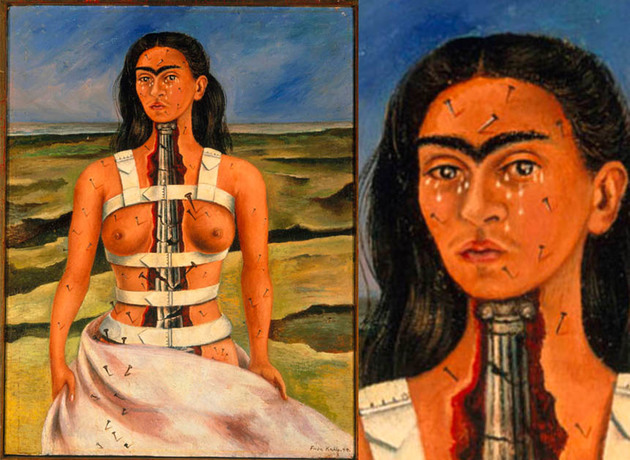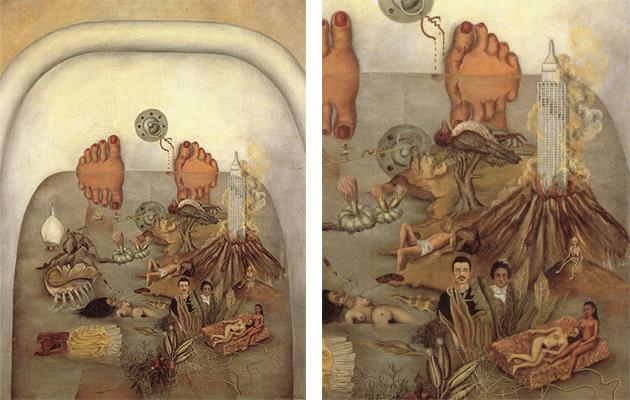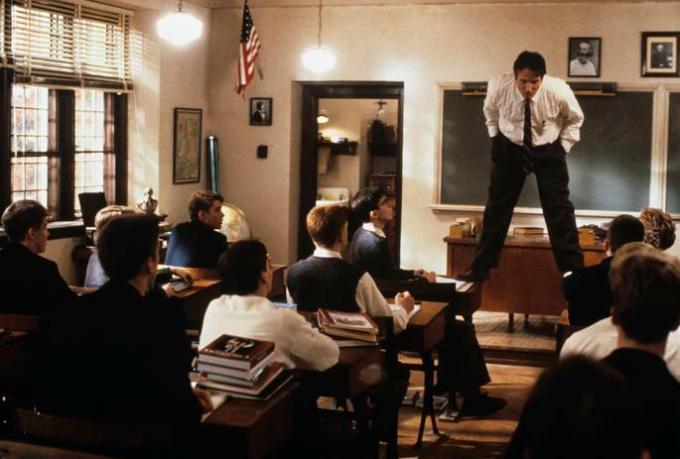Frida Kahlo's works arouse the curiosity and admiration of many people. Many of the themes represented on the Mexican artist's canvases are related to her personal life.
She was considered a surrealist artist, even participating in an exhibition of this artistic trend. However, she did not see herself as a surrealist, as she said that "she didn't paint dreams but her reality".
The fact is that Frida's paintings usually bring a stimulating, mysterious and unusual atmosphere. She managed to convey in her art many of her feelings and anxieties in a fantastic way.
Therefore, we selected some works by Frida Kahlo so that you can learn more about this important Latin American artist. Check out!
1. A few piquetitos (Some small cuts)

This striking canvas was produced in 1935. At the time, Frida Kahlo had read a newspaper report reporting that a man stabbed his partner to death. When asked about the crime, the man replied that it was "a few small cuts".
Frida then decided to portray the scene in a very disturbing work of art. In it, the artist displays the naked, bloody and lifeless body of a woman in a bed. Her husband is beside her holding a knife with a slight smile on his face.
There are blood marks all over the room, including a kind of frame painted on the canvas. Above, there are also two birds that hold a banner that says: One number of piquettes.
We can see in this work the importance that art also has in social and everyday affairs.
The artist used her work to take a stand and denounce the many cases of murder of women, which for a long time was called "crime of passion".
This type of crime, which men commit against women out of the feeling of "possession", is currently called femicide.
The painting has dimensions of 30 x 40 cm and is part of the collection of the Dolores Olmedo Museum, in Mexico.
2. My birth (My birth)

This picture dates from 1932. In it, Frida portrays what would have been her birth, or as she said "how i imagined i was born".
In the scene, we see the artist's mother in her labor; she is covered from the waist up with a white sheet, as if she were dead.
On the child's face, we already notice Frida's striking expression, which comes out of her womb almost on its own.
The painter's mother, Matilde Gonzalez y Calderón, had religiosity as a fundamental point of her life, which is represented by a painting above the bed showing the image of the Virgin of Laments.
After her birth, Frida's mother is known to have suffered from postpartum depression and, shortly thereafter, she became pregnant again.
This work, therefore, brings us several questions about life and death, rebirth, suffering and loneliness.
The canvas, measuring 30 x 53 cm, is part of a private collection.
3. El venado hereido (The wounded deer)

Produced in 1946, this is a work in which Frida expels part of her physical and emotional pain. Such suffering came as a result of her failing health and also her complicated marriage to fellow painter Diego Rivera.
In this self-portrait, the painter appears in a zoomorphic figure, that is, part animal, part human.
The deer was the chosen animal, perhaps because it is a sweet, graceful and at the same time vulnerable creature. The artist was also very close to animals and, throughout her life, took care of several of them, including a deer.
In the scene, the animal's body is pierced by nine arrows, yet Frida's features convey perseverance and haughtiness. It's like moving forward even in the face of life's adversities.
The arrowed body also makes reference to Saint Sebastian, a man who dedicated his life to the Christian faith in the first centuries of Christianity, at a time when there was still persecution of the religion. Sebastian was tied to a tree and badly wounded by arrows.
The canvas has a size of 30 x 22 cm and was given by Frida to close friends as a wedding gift.
4. Mi nana y yo (My nana and I)

In My nana and yo, produced in 1937, Frida portrays an important part of her childhood.
When Frida came into the world, her mother soon became pregnant again, which resulted in the birth of her sister Cristina, when the artist was just 11 months old.
Because of this, Frida had to be breastfed by a wet nurse who, in this case, was an indigenous woman.
In the painting, Frida appears with a baby's body and an adult's head; her nanny hers is shown as a large dark-skinned woman, who feeds her with her full breasts. In place of the woman's face, there is a pre-Columbian mask, which carries enormous historical weight, in addition to suggesting the emotional distance between them.
On the right breast, where the artist breastfeeds, there is a representation of what would be the mammary glands; in the left breast, a drop of milk drips.
Note that, in the scene, there is a rain with thick white drops, like the one from the milk that feeds Frida. This rain irrigates vegetation behind the figures and gives rise to a large white leaf.
The composition measures 30.5 x 36.83 cm and is part of the Dolores Olmedo collection, located in Mexico City.
5. El sueño, the La Cama (The dream, or The bed)

In this work, from 1940, the oneiric universe merges with the idea of death. Here, Frida portrays herself sleeping in a four-poster bed, the same model she slept in every day.
The artist is lying down while a climbing plant entwines her body, in a symbol of life. However, on top of the bed, a huge skeleton is also lying in the same position. The skeleton serves as a reminder that life is fleeting and death invariably comes.
The environment where the bed is inserted is diffuse, without contours, and the bed seems to float. This suggests another dimension, or even that the scene takes place in the clouds.
The work can also be directly related to the expression in Latin Somnus est frater mortis, which means "Sleep is death's brother".
It is important to emphasize that, in Mexico, the skeletal figure and the concept of death are part of the culture, and are revered in the so-called "Day of the Dead", which takes place annually on January 2nd.
Maybe that's why Frida justifies this screen saying that it's a "fun reminder of mortality", to which we are all subject.
The work measures 74 x 98 cm and belongs to a private collection.
6. La columna rota (The broken column)

This is a very autobiographical work, as are most of her canvases.
Here, she portrays all her suffering as a result of a surgery she underwent on her spine, as a result of a serious accident she suffered when she was 18 years old.
On the screen, we see Frida with her torso bare and an opening showing a Greek column in the center of her body. The column is all broken into pieces and supports the painter's head. There is also a kind of corset tying her body-the artist actually wore several of these medical vests during her lifetime..
Her body is covered by many nails, symbolizing pain points. The facial expression shows firmness and resilience, however, the thick tears portrayed reveal an intense physical and emotional pain.
Note that the artist is inserted in an arid landscape, which gives an even more painful tone to the canvas.
The composition measures 39.8 x 30.7 cm and belongs to the Dolores Olmedo collection, in Mexico.
7. Lo que el agua medio (What the water gave me)

In this 1939 self-portrait, Frida Kahlo paints her feet in a bathtub. From the bath water, figures, scenes and situations emerge that were part of the artist's life, as a kind of synthesis of her existence.
The work was inspired by another work, entitled My grandparents, my parents and me, in which Frida portrays her ancestors in the form of a family tree. Her father figure is repeated on both screens.
Other elements are portrayed, some evoking the suffering Frida was subjected to for many moments, her bisexuality, her idea of death, among others.
This canvas was considered surrealist by André Breton (one of the creators of the surrealist movement in France), when he was in Mexico and saw the work. At the time, Frida was surprised and said she didn't know she was a surrealist, until she was classified as one.
The job was offered by Frida to photographer Nickolas Muray, who was her lover, as payment for a debt.
This is a production with dimensions of 91 x 70 cm and today belongs to Daniel Filipacchi's collection.
Who was Frida Kahlo?

Magdalena Carmen Frida Kahlo y Calderón, Frida, was born in 1907 in the village of Coyoacán, near Mexico City. Her father was a German photographer and her mother was Mexican.
The artist's life was marked by several tragic episodes. When she was 6 years old, she fell ill, contracting polio.
Then, at age 18, she had a serious tram accident, when she was bedridden for a long time and from then on began to paint.
In 1928, she joins the Mexican Communist Party and there meets the mural painter Diego Rivera, with whom she falls in love and begins a long marital history.
Frida dedicated herself to painting all her life, and in addition to producing art, she was also a teacher in Mexico City at the National School of Painting and Sculpture “La Esmeralda” (La Esmeralda).
On July 13, 1954, aged 47, Frida dies of pneumonia.
To also know about important works by other artists, read:
- Most famous paintings in the world
- Portinari works you need to know
- Modernist works by Tarsila do Amaral
- Works by Salvador Dalí that will impress you
- Important works of cubism



